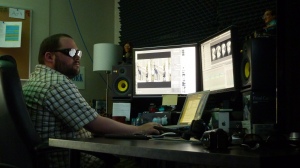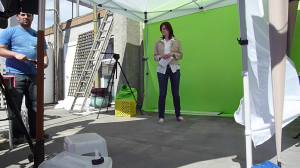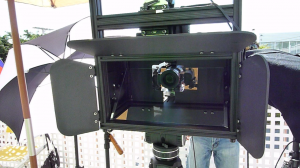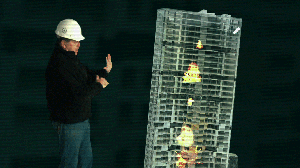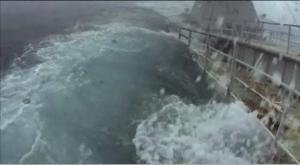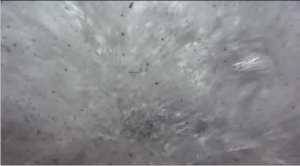Editing a 3D documentary: JVC HD 3D LCD monitor review
Our HD 3D monitor has arrived!
It’s the 46-inch JVC GD-463D10, and it means our editor, Brian Mann, doesn’t have to view footage in anaglyph anymore.
Moving to polarized is a relief – no colour loss, no red and cyan ghosting … and no headaches.
Purchasing the monitor ($6,600 later) was obviously a must – you can’t produce a high quality 3D show, like the first 3D documentary we’re going to shoot, editing in anaglyph.
We managed to fit it into an edit suite and set it up. Brian, Jakub and I check out some VFX footage on our newest 3D toy:
When it comes time to cut this Blowdown, Brian will use the monitor to see what he’s editing in Final Cut Pro (which, as I’ve mentioned, can’t edit in 3D without third party program help – we’re trying Cineform Neo3D out).
This view is key – cutting 3D shots means there’s a lot more to consider – parallax, convergence, wide and close, how much positive depth/negative depth exists in each shot.
If you cut shots with huge discrepancies in depth it’s really uncomfortable to watch, so you can’t just chop shots together – even with a flashy transition.
The only rub with the monitor is that it doesn’t do dual stream, which means the footage is technically at half-resolution (ie. don’t get both eyes full res).
So even though we’re editing in dual stream (to deliver the highest quality possible), we can’t view it that way on the JVC screen.
We looked into dual stream monitors – Panasonic’s due to release a 25-inch unit in the fall – but it’s prohibitively expensive (approximately $10,000).
And, more importantly, it’s too small for us to view our footage in a size that’s representative of our final product (how many 25-inch televisions have you seen lately?) – a shortfall that could lead to convergence that isn’t optimal for our audience.
Oh, and the JVC came with two free pairs of polarized glasses.
Looks like we’ll do just fine:
Editor Brian Mann works with the JVC HD 3D LCD monitor
